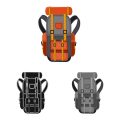Understanding Your Trip
Choosing the right backpack starts with knowing your journey. In the U.S., outdoor adventures range from quick weekend hikes to immersive week-long explorations in national parks like Yosemite or Zion. The duration of your trip shapes everything: how much gear you need, what kind of clothing you’ll pack, and even how much food and water you should carry. Day hikers often stick to lighter trails close to home, where a small daypack is ideal for essentials like snacks, water, and a rain jacket. On the other hand, multi-day trekkers—think backpacking in the Rockies or camping through the Smokies—need larger packs designed for carrying tents, sleeping bags, and days’ worth of supplies. Considering both your activity and trip length ensures your backpack matches your adventure, whether you’re hitting local trails or heading out for an extended escape into wild American landscapes.
Daypack Essentials
When your adventure is short and sweet, a daypack is the perfect companion. In the U.S., daypacks are a staple for city hikes, quick escapes to local parks, or classic half-day summit pushes in national forests. The right daypack balances simplicity and utility—small enough to move freely, yet roomy enough for all your essentials.
Key Features of an Ideal Daypack
- Capacity: Most daypacks range from 15 to 30 liters, just enough for water, snacks, a light jacket, and a few personal items.
- Weight: Lightweight construction keeps you nimble on the go.
- Pockets: Look for smart storage—side pockets for water bottles, zippered compartments for keys and wallets, and maybe a stash pocket for sunglasses or maps.
- Hydration Compatibility: Many U.S. hikers favor hydration sleeves or dedicated bottle pockets for easy access on hot days.
- Comfort: Breathable back panels and padded straps make spontaneous outings more enjoyable.
What Works Best for Short Trips?
| Feature | Why It Matters | Typical Use Case |
|---|---|---|
| 15-20L Capacity | Keeps load light; fits basics only | Urban trails, city walks, quick errands |
| 20-30L Capacity | Adds room for layers and lunch | Half-day hikes, summit attempts, park picnics |
| Slim Profile | Maneuvers easily in crowds or dense woods | Crowded trailheads, forest paths |
| Weather Resistance | Protects gear from sudden showers | Packed schedules, unpredictable climates |
| Sustainable Materials | Eco-friendly choices reflect nature values | Environmentally conscious trips |
The Takeaway for U.S. Outings
A good daypack is about freedom—grab it from the closet and go. Whether you’re catching sunrise on a local ridge or exploring urban greenways after work, choose one that suits your style and holds just what you need. Minimalist design meets maximum experience: that’s the essence of the perfect daypack for American adventures.

3. Multi-Day Backpack Advantages
Multi-day backpacks are designed for those who seek more than just a quick getaway—they’re built for the long haul. For Americans who love backcountry camping or week-long hiking trips, these packs stand out in three key areas: comfort, storage, and organization.
Comfort for the Long Journey
On extended adventures, comfort isn’t optional—it’s essential. Multi-day packs come with padded hip belts, ergonomic shoulder straps, and adjustable frames that help distribute weight evenly. This means you can trek further without feeling weighed down, making them a go-to choice for longer journeys through the wilderness.
Ample Storage Space
Unlike daypacks, multi-day backpacks offer generous capacity, often ranging from 50 to 80 liters. There’s room for sleeping bags, tents, extra clothing, and days’ worth of food. Whether you’re exploring national parks or embarking on a thru-hike, you’ll have space to carry all your essentials and more.
Thoughtful Organization
Organization matters when you’re living out of your pack for several days. Multi-day backpacks feature multiple compartments, hydration sleeves, and exterior pockets for quick-access items. This smart design helps you stay organized on the trail, so you spend less time rummaging and more time enjoying nature’s quiet beauty.
Perfect for American Adventures
If your trip takes you deep into the backcountry or keeps you on the trail for nights at a time, a multi-day backpack is your reliable companion—supporting your journey from sunrise to star-filled nights under the open sky.
4. Weight, Comfort, and Fit
When choosing between a multi-day backpack and a daypack, weight distribution, ergonomic design, and proper fit are essential factors for American hikers and travelers. The right balance of these elements can make the difference between an enjoyable journey and one marked by discomfort or even injury. Outdoor brands popular in the U.S., such as Osprey, Gregory, and Deuter, have introduced innovative features to address these needs.
Weight Distribution: Why It Matters
Good weight distribution reduces strain on your back and shoulders, allowing you to hike longer with less fatigue. Multi-day packs typically feature internal frames and adjustable hip belts that help transfer most of the load from your shoulders to your hips. Daypacks, though smaller, should also offer padded straps and a stable back panel to ensure comfort during shorter trips.
Ergonomic Design Innovations
Recent trends among U.S. outdoor gear brands include ventilated mesh back panels that minimize sweat, contoured shoulder straps tailored for different body shapes, and quick-adjust suspension systems. These features allow users to fine-tune their pack’s fit on the go, responding to changing terrain and load requirements.
Finding the Right Fit: A Comparison Table
| Feature | Multi-Day Backpack | Daypack |
|---|---|---|
| Load Capacity | 40–70+ liters; supports heavier gear | 10–30 liters; for essentials only |
| Main Support System | Internal frame + hip belt | Padded straps; minimal/no frame |
| Adjustability | Fully adjustable harness & torso length | Basic strap adjustments |
| Comfort Features | Sternum strap, lumbar support, ventilation channels | Slim profile, breathable mesh back panel |
| Best For | Overnight/multi-day treks & heavy loads | Short hikes, city exploring, day trips |
The Takeaway for U.S. Hikers and Travelers
Selecting a backpack with optimal weight distribution, ergonomic design, and a personalized fit ensures safety and enjoyment on any adventure—whether you’re tackling the Pacific Crest Trail or strolling through a national park for the afternoon. Invest time in trying on different models; what feels right at home may feel different after hours on the trail. Remember: comfort is not a luxury—it’s essential for every journey.
5. Packing Mindfully
When deciding between a multi-day pack and a daypack, how you pack is just as important as what you carry. The American ethos of Leave No Trace encourages us to move through nature lightly, with respect for the wilderness and those who come after us. Minimalist packing is key—bring only essentials that serve multiple purposes. Choose lightweight gear, reusable containers, and biodegradable toiletries. Lay out everything you think you need, then remove half. Embrace natural simplicity by favoring neutral colors that blend with the environment and tools made from sustainable materials. Whether your trip is short or long, mindful packing not only lightens your load but also honors the land. Leave every trail just as wild and beautiful as you found it.
6. Making Your Choice
Choosing the right backpack is about balance—between your personal needs and the spirit of American outdoor adventure. Begin by honestly evaluating your trip’s demands: Are you heading out for a single day on a local trail or gearing up for a multi-night journey in the wilderness? Consider your essentials. Make a list of what you truly need, not just what you want to bring. This helps keep your load light and your mind focused.
Assess Comfort and Fit
Test backpacks before you buy. Wear them loaded with weight, walk around, adjust the straps. A good fit should hug your body without pinching or slipping. Remember, comfort is key—especially when miles add up under the big sky.
Match Function to Adventure
If your trip is short and sweet, choose a daypack that lets you move freely and keeps things simple. For longer journeys, prioritize space and support. Look for features like hydration sleeves, multiple compartments, or reinforced frames—hallmarks of packs designed for the American backcountry.
Reflect Your Values
Choose gear that supports the Leave No Trace ethic and respects wild spaces. Many American outdoor brands offer durable, sustainable options that align with these values—packs made to last through seasons of sun, rain, and discovery.
Ultimately, select a backpack that fits both your journey and your sense of self. Whether you’re exploring national parks or neighborhood trails, let your pack be an extension of your commitment to simplicity, resilience, and connection with nature.


